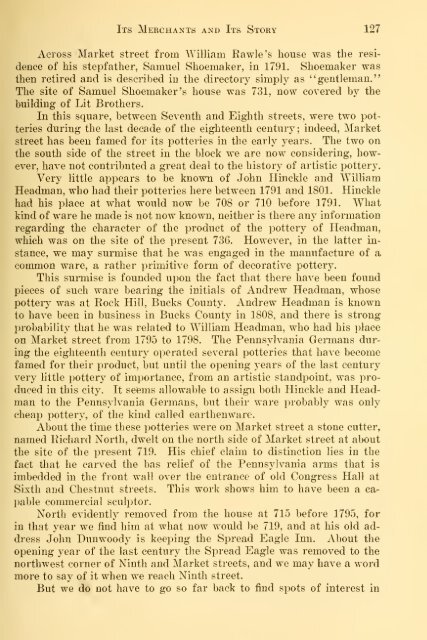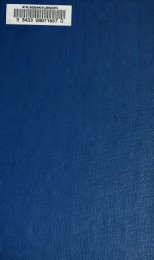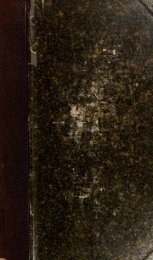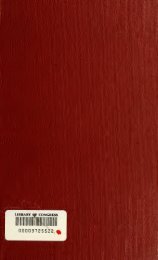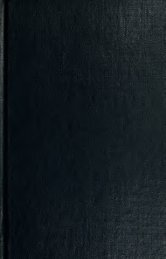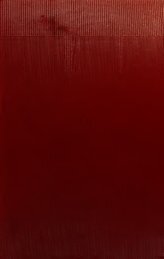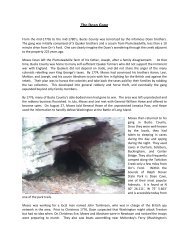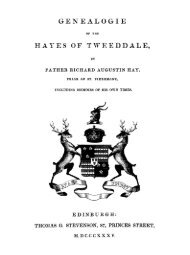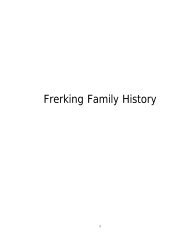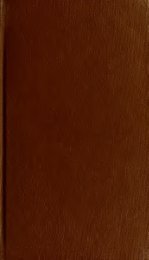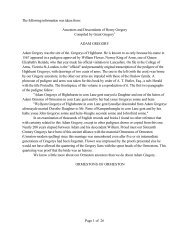Market street, Philadelphia; the most historic ... - Hay genealogy
Market street, Philadelphia; the most historic ... - Hay genealogy
Market street, Philadelphia; the most historic ... - Hay genealogy
Create successful ePaper yourself
Turn your PDF publications into a flip-book with our unique Google optimized e-Paper software.
Its Merchants and Its Story 127<br />
Across <strong>Market</strong> <strong>street</strong> from William Rawle's house was <strong>the</strong> residence<br />
of his stepfa<strong>the</strong>r, Samuel Shoemaker, in 1791. Shoemaker was<br />
<strong>the</strong>n retired and is described in <strong>the</strong> directory simply as "gentleman."<br />
The site of Samuel Shoemaker's house was 731, now covered by <strong>the</strong><br />
building of Lit Bro<strong>the</strong>rs.<br />
In this square, between Seventh and Eighth <strong>street</strong>s, were two potteries<br />
during <strong>the</strong> last decade of <strong>the</strong> eighteenth centuiy; indeed. <strong>Market</strong><br />
<strong>street</strong> has been famed for its potteries in <strong>the</strong> early years. The two on<br />
<strong>the</strong> south side of <strong>the</strong> <strong>street</strong> in <strong>the</strong> block we are now considering, however,<br />
have not contributed a great deal to <strong>the</strong> history of artistic pottery.<br />
Very little appears to be known of John Hinckle and William<br />
Headman, who had <strong>the</strong>ir potteries here between 1791 and 1801. Hinckle<br />
had his place at what would now be 708 or 710 before 1791. What<br />
kind of ware he made is not now known, nei<strong>the</strong>r is <strong>the</strong>re any infonnation<br />
regarding <strong>the</strong> character of <strong>the</strong> product of <strong>the</strong> pottery of Headman,<br />
which was on <strong>the</strong> site of <strong>the</strong> present 736. However, in <strong>the</strong> latter instance,<br />
we may surmise that he was engaged in <strong>the</strong> manufacture of a<br />
common ware, a ra<strong>the</strong>r primitive form of decorative pottery.<br />
This sunnise is founded upon <strong>the</strong> fact that <strong>the</strong>re have been found<br />
pieces of such ware bearing <strong>the</strong> initials of Andrew Headman, whose<br />
pottery was at Rock Hill, Bucks County. Andrew Headman is known<br />
to have been in business in Bucks County in 1808, and <strong>the</strong>re is strong<br />
probability that he was related to William Headman, who had his place<br />
on <strong>Market</strong> <strong>street</strong> from 1795 to 1798. The Pennsylvania Germans during<br />
<strong>the</strong> eighteenth century operated several potteries that have become<br />
famed for <strong>the</strong>ir product, but until <strong>the</strong> opening years of <strong>the</strong> last century<br />
very little pottery of importance, from an artistic standpoint, was produced<br />
in this city. It seems allowable to assign both Hinckle and Headman<br />
to <strong>the</strong> Pennsylvania Germans, but <strong>the</strong>ir ware probably was only<br />
cheap pottery, of <strong>the</strong> kind called ear<strong>the</strong>nware.<br />
About <strong>the</strong> time <strong>the</strong>se potteries were on <strong>Market</strong> <strong>street</strong> a stone cutter,<br />
named Richard North, dwelt on <strong>the</strong> north side of <strong>Market</strong> <strong>street</strong> at about<br />
<strong>the</strong> site of <strong>the</strong> present 719. His chief claim to distinction lies in <strong>the</strong><br />
faxjt that he carved <strong>the</strong> bas relief of <strong>the</strong> Pennsylvania arms that is<br />
imbedded in <strong>the</strong> front wall over <strong>the</strong> entrance of old Congress Hall at<br />
Sixth and Chestnut <strong>street</strong>s. This work shows him to have been a capable<br />
commercial sculptor.<br />
North evidently removed from <strong>the</strong> house at 715 before 1795, for<br />
in that year we find him at what now would be 719, and at his old address<br />
John Dunwoody is keeping <strong>the</strong> Spread Eagle Inn. About <strong>the</strong><br />
opening year of <strong>the</strong> last century <strong>the</strong> Spread Eagle was removed to <strong>the</strong><br />
northwest corner of Ninth and <strong>Market</strong> <strong>street</strong>s, and we may have a word<br />
more to say of it when we reach Ninth <strong>street</strong>.<br />
But we do not have to go so far back to find spots of interest in


